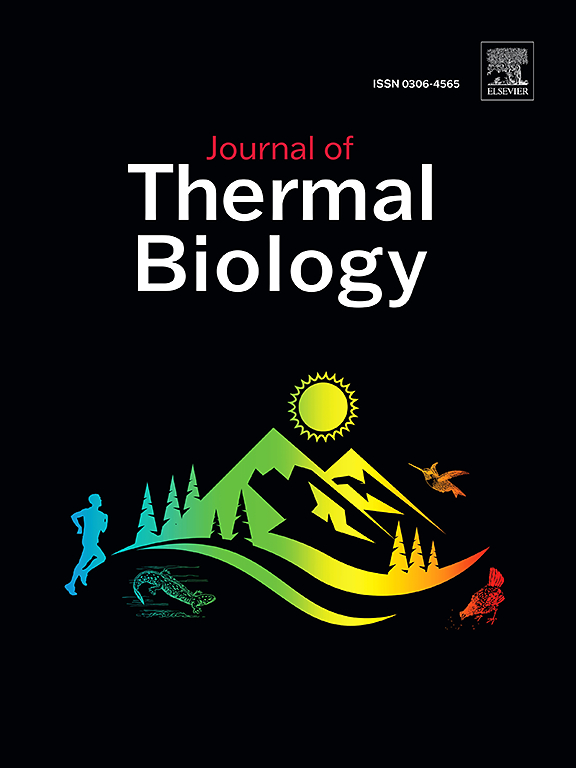Effects of exercise intensity on skin temperature and muscle oxygen saturation in the thigh during and after strength resistance training
IF 2.9
2区 生物学
Q2 BIOLOGY
引用次数: 0
Abstract
This study aimed to describe and correlate the skin temperature (Tsk) and muscle oxygen saturation (SmO2) during leg extension exercises with higher load (HL) and lower-load (LL) demands. Seventeen active men (age: 25.6 ± 3.4 years) participated by performed 3 x 15 repetitions of leg extension at 70 % of 1RM (HL) and 35 % of 1RM (LL). The Tsk of the thigh, knees, and legs were recorded with a thermal camera. SmO2 was assessed using non-invasive near-infrared spectroscopy (NIRS) technology. The percentage of muscle oxygen extraction (∇%SmO2) and the hyperaemic response (Δ%SmO2) in the vastus lateralis (VL) was calculated. Also, the rating of perceived exertion (RPE) scale data was obtained. Data were collected after warm-up (Baseline), after the first set (Set 1), second set (Set 2), third set (Set 3), and twice during recovery (7 min and 15 min). The results indicate an increase in Tsk thigh from baseline to recovery, which was more differenced in the HL group (Tsk = 30.44 ± 1.24 °C to 31.38 ± 1.32 °C) than in the LL group (Tsk = 30.86 ± 0.96 °C to 31.32 ± 1.06 °C). Similarly, SmO2 decreased during exercise, more in the HL group than in the LL group (SmO2 = 18 ± 15 % vs. 23 ± 15 %), and ∇%SmO2 increased more in the HL group than in the LL group (SmO2 = 75 ± 20 % vs. 65 ± 20 %). Additionally, during recovery, the hyperaemic response was higher in HL group than in LL group (SmO2 = 12 ± 14 % vs. 3.1 ± 9.1 %). The RPE was also higher in HL group (9.5 ± 0.6) than in LL group (4.8 ± 1.3). Moreover, the increase in Tsk thigh was associated with ∇%SmO2 during exercise (r2 = 0.43 to 0.55) and recovery (r2 = 0.31 to 0.52). Tsk and SmO2 metrics reflect metabolic changes occurring during and after resistance training, which can be useful for monitoring the internal response to the workout.
运动强度对力量阻力训练期间和之后大腿皮肤温度和肌肉氧饱和度的影响
本研究旨在描述腿部伸展运动中皮肤温度(Tsk)和肌肉氧饱和度(SmO2)与高负荷(HL)和低负荷(LL)需求之间的关系。17名活跃男性(年龄:25.6±3.4岁)以70%的1RM (HL)和35%的1RM (LL)进行3 x 15次重复的腿部伸展。用热像仪记录大腿、膝盖和腿部的温度。采用非侵入性近红外光谱(NIRS)技术评估SmO2。计算股外侧肌(VL)的吸氧率(∇%SmO2)和充血反应(Δ%SmO2)。同时,获得感知运动强度评分(RPE)量表数据。在热身(基线)、第一组(set 1)、第二组(set 2)、第三组(set 3)和恢复期间(7分钟和15分钟)两次收集数据。结果显示,从基线到恢复期间,Tsk大腿升高,HL组(Tsk = 30.44±1.24°C至31.38±1.32°C)比LL组(Tsk = 30.86±0.96°C至31.32±1.06°C)差异更大。同样,在运动过程中,HL组的SmO2下降幅度大于LL组(SmO2 = 18±15% vs. 23±15%),HL组的∇%SmO2增加幅度大于LL组(SmO2 = 75±20% vs. 65±20%)。此外,在恢复期间,HL组的充血反应高于LL组(SmO2 = 12±14%比3.1±9.1%)。HL组RPE(9.5±0.6)高于LL组(4.8±1.3)。此外,Tsk大腿的增加与运动期间的∇%SmO2 (r2 = 0.43 ~ 0.55)和恢复(r2 = 0.31 ~ 0.52)相关。Tsk和SmO2指标反映了在阻力训练期间和之后发生的代谢变化,这对于监测锻炼的内部反应是有用的。
本文章由计算机程序翻译,如有差异,请以英文原文为准。
求助全文
约1分钟内获得全文
求助全文
来源期刊

Journal of thermal biology
生物-动物学
CiteScore
5.30
自引率
7.40%
发文量
196
审稿时长
14.5 weeks
期刊介绍:
The Journal of Thermal Biology publishes articles that advance our knowledge on the ways and mechanisms through which temperature affects man and animals. This includes studies of their responses to these effects and on the ecological consequences. Directly relevant to this theme are:
• The mechanisms of thermal limitation, heat and cold injury, and the resistance of organisms to extremes of temperature
• The mechanisms involved in acclimation, acclimatization and evolutionary adaptation to temperature
• Mechanisms underlying the patterns of hibernation, torpor, dormancy, aestivation and diapause
• Effects of temperature on reproduction and development, growth, ageing and life-span
• Studies on modelling heat transfer between organisms and their environment
• The contributions of temperature to effects of climate change on animal species and man
• Studies of conservation biology and physiology related to temperature
• Behavioural and physiological regulation of body temperature including its pathophysiology and fever
• Medical applications of hypo- and hyperthermia
Article types:
• Original articles
• Review articles
 求助内容:
求助内容: 应助结果提醒方式:
应助结果提醒方式:


